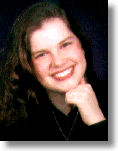
Trisha Borgman - February 22, 1996

|
"Taking Pictures With Rain Buckets" Trisha Borgman - February 22, 1996 |
|
Well, this is a great place to start my journals, because I'm just now starting to
work with a new set of data!
I said in my biography statement that when astronomers come back from observing at a
telescope, I am given a tape which contains all of the data from their observing run.
This tape is just about the same size and shape as a cassette tape for a stereo, and it
stores information digitally. This means that all the data is stored as a series of
numbers (1's and 0's). The computer then "reassembles" the data from the 1's and 0's
into a picture of exactly what the astronomer saw through the telescope.
A lot of people ask me exactly how a picture is taken through a telescope, and that's
a good question. It used to be that the only way to take a picture through a telescope
was with a camera. These pictures would usually be exposed on glass plates, but would be
more or less like the photos you take with a "normal" camera. But the problem with using
photographs is that they're not very efficient. For everyday purposes, like taking
pictures of you and your friends, photographs work great. However, taking pictures of
stars is a lot more difficult because there's so little light coming into the
telescope--photographs just couldn't capture enough light!
Not too long ago, the CCD was invented. CCD stands for "charge coupled device." A CCD
is MUCH more efficient than photographic plates, and therefore it's perfect to use when
taking pictures of stars! So how does it work? A CCD is a lot like a whole bunch of rain
buckets arranged in rows. It's usually square in shape, and just like rain buckets
capture each individual raindrop, a CCD captures each photon of light. (You can think of
a photon as the smallest possible particle of light/energy.) If you have a square array
of rain buckets, each bucket would record how much rain fell at each location, right?
Well, in a CCD, each miniature "bucket" records how many photons hit each point. The
computer then converts all of the information about how many photons hit at each point
into a picture.
But CCDs aren't perfect, and the first thing I have to do when I get a new set of data
is to get rid of the "signatures" of the CCD itself. These "signatures" are a series of
flaws in the image as a result of the CCD itself. Astronomers understand very well where
these flaws come from, as well as how to get rid of them. In fact, huge computer programs
have been written so that all I have to do is feed the data into the correct
programs...and the computer does most of the work! That's what I'm doing right now! It
usually takes several hours to run a night's worth of data through these computer
programs--a lot of what astronomers do today just wouldn't be possible without computers!
Well, I've got to go to class now... I'll be sure to explain more about CCDs and how
I work with the data next time. Have a good week!
|
| Back to Field Journals Menu | Back to Trisha Borgman's Journals | Taking Pictures With Rain Buckets 1 |
![]()